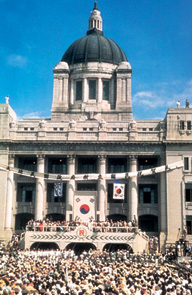
A special ceremony inaugurating the government of the Republic of Korea was held on August 15. 1948.
Koreans rejoiced at Japan's World War II defeat. However, their joy was short-lived. Liberation did not instantly bring about the independence for which the Koreans had fought so fiercely. Rather, it resulted in a country divided by ideological differences caused by the emerging Cold War. Korean efforts to establish an independent government were frustrated as U.S. forces occupied the southern half of the peninsula and Soviet troops took control of the north.
In November 1947, the United Nations General Assembly adopted a resolution that called for general elections in Korea under the supervision of a UN Commission.
However, the Soviet Union refused to comply with the resolution and denied the UN Commission access to the northern half of Korea. The UN General Assembly then adopted another resolution calling for elections in areas accessible to its commission.
The first elections in Korea were carried out on May 10, 1948, in the areas south of the 38th parallel. This parallel came to divide the Korean Peninsula into South and North.
Syngman Rhee was elected the first President of the Republic of Korea in 1948. Meanwhile, north of the 38th parallel, a communist regime was set up under the leadership of Kim Il-sung.
On June 25, 1950, North Korea launched an unprovoked full-scale invasion of the South, triggering a three-year war which drew in U.S., Chinese and other foreign forces. The entire peninsula was devastated by the conflict. A cease-fire was signed in July 1953.
Korea's growth-oriented, export-led economic development since the 1960s was so remarkable that it earned the expression "the Miracle on the Hangang River" in the 1970s. Subsequently, Seoul successfully hosted the 24th Olympics in 1988 and Korea co-hosted the 2002 FIFA World Cup soccer finals with Japan. Through these occasions, Korea has demonstrated to the world its rich cultural heritage and love of art, as well as modern technologies. In the 1950s, Korea ranked among the poorest countries. Today, its economy is around the 13th largest in the world, and the nation is determined to become even more of a global economic leader throughout the new millennium.
The Republic of Korea has steadily followed the path to mature democracy and market economy. Even though the legacies of the Cold War still linger on this peninsula, Korea today is poised to make a new economic take-off. The Koreas are also working toward a durable structure of peace on the peninsula and promoting common prosperity for South and North Korea through peace, reconciliation and cooperation.